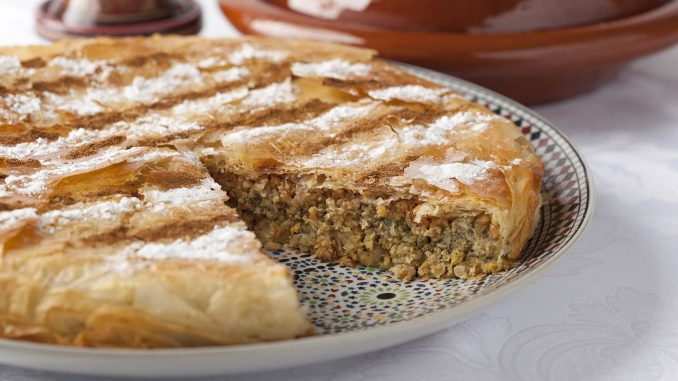
Pastilla is one of the most famous and delicious traditional Moroccan dishes. It is served during large ceremonies and festivities to celebrate special guests. Its preparation involves a mixture of sweet and savory ingredients: pasta, onions, parsley and coriander, hard-boiled eggs, noodles and almonds. It is stuffed with chicken, turkey or pigeon added to powdered sugar and cinnamon which give it a unique flavor. Pastilla can also be stuffed with fish and seafood, depending on the region of Morocco. For example, the Fassis prefer it with chicken or pigeon, while the inhabitants of the north prefer it with seafood. Pastilla can be served as a dessert, especially in Fez, where it is prepared with milk, sugar, almonds and rose water.
Different stories are told about the origins of this dish. Indeed, “pastilla” is a Spanish word meaning “little pancake” or cake, and it is said to have originated in Andalusia. It is said to have arrived in the Arab Maghreb through the immigration of the Arabs, but some Moroccan researchers claim that the origins of this dish are Amazighes, and therefore it originated in Morocco and was transferred to Andalusia, then the Arabs brought it back here after the fall of Andalusia. Several British sources have affirmed that the Pastilla was known in the times of the Saadians and had a recognized place. British ambassadors described it as being stuffed with almonds and pigeons, and that it was presented in Morocco as an appetizer but had all the makings of a main course. Other sources have indicated that it was known in the times of the Almohads and that it is mentioned in several culinary books of their time.
Several Spanish researchers have also claimed that the origins of this dish are from Fez. It left the royal palaces to become a dish that is eaten by all Moroccans and then became international.
Despite its existence in Algeria where it is called “Rezima” and in Tunisia where it is called “Tajine Malsouka”, the Pastilla remains a Moroccan dish and a symbol of the Moroccan culinary art.

Be the first to comment